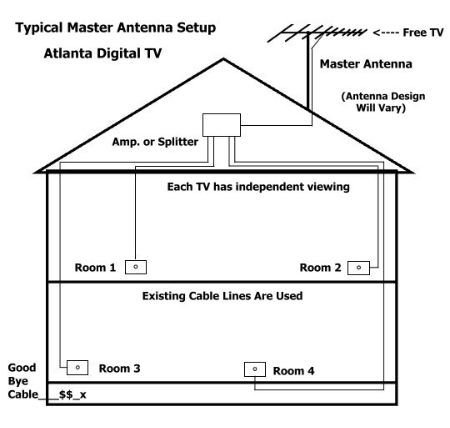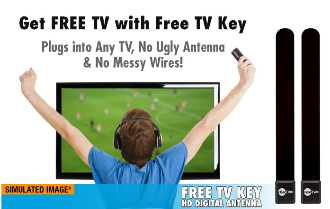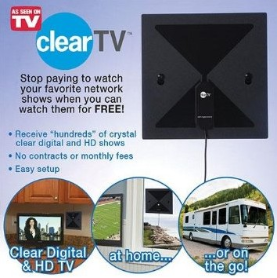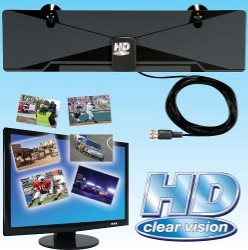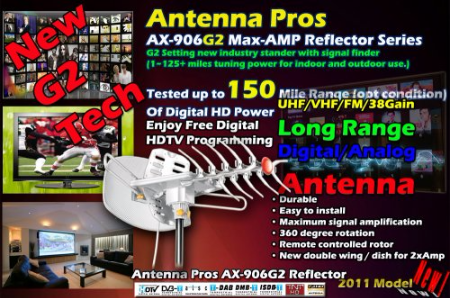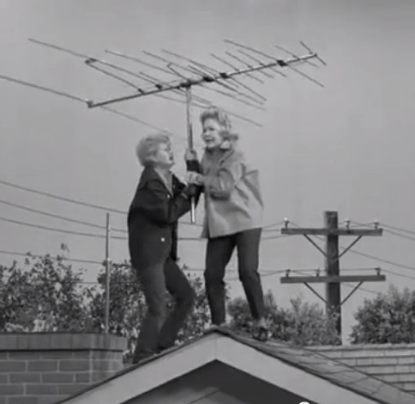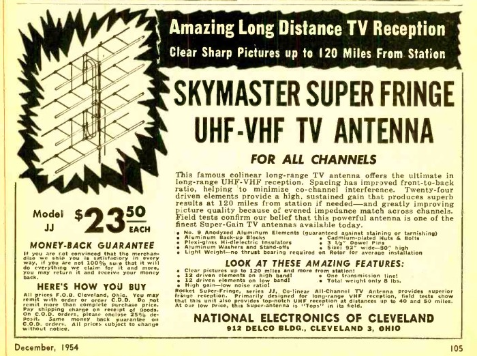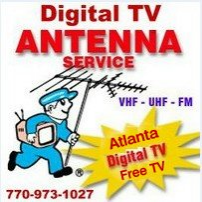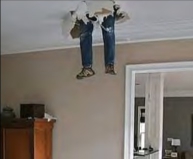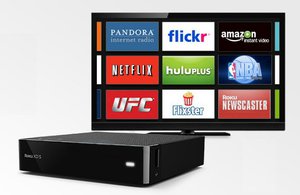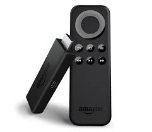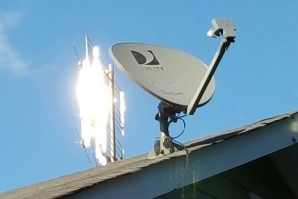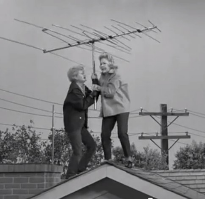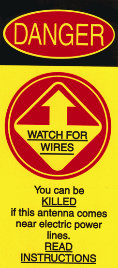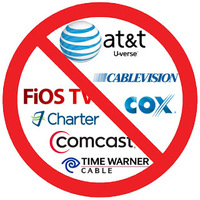
Helpful Information "FYI"
__________________________________________________________________
Typical Master Home Antenna Install
__________________________________________________________________
AS Seen On TV
All other similar "hyped" plug in antennas; Don't Waste Your Money!
__________________________________________________________________
There are no 150 mile HDTV antennas
You may see internet ads like this popping up! Don't be fooled, there is no 150 mile TV antenna with 38-dB gain made out of plastic with a little motor, made in China from $39 to $69. Yes, it's all marketing garbage. Sure, it'll pick up some strong stations, but you can receive TV signals with a coat hanger if correctly wired and positioned. UHF TV signals work in interesting ways and traveling over 60 miles is rare. At 150 miles, the curvature of the earth comes into play. Physical antenna size and height above ground is what matters when dealing with TV reception, or any radio/TV transmission. I have seen customers order these only to discover too late that it was junk. If it sounds too good to be true... I'll agree these little plastic antennas do look cool, but that's all, most of the fins & dishes are for looks and are not functional. They are little more than fancy rabbit ears and perform as well. Don't waste your money.
__________________________________________________________________
__________________________________________________________________
Considering Installing an Antenna Yourself?
The fun starts at 10 minutes into the video, skip ahead if you like.
Click The Picture Below To Go To The Video
__________________________________________________________________
This was a long-range antenna in 1954
__________________________________________________________________
Many pay-TV customers are tuning out
Economy and Internet damage cable, satellite industry
The weak economy is hitting Americans where they spend a lot of their free time: at the TV set. They're canceling or forgoing cable and satellite TV subscriptions in
record numbers, according to an analysis by The Associated Press of the companies' quarterly earnings reports. The U.S. subscription-TV industry first showed a small net loss of subscribers a year
ago. This year, that trickle has turned into a stream. The chief cause appears to be persistently high unemployment and a housing market that has many people living with their parents, reducing the
need for a separate cable bill.
The Internet influence
But it's also possible that people are canceling cable, or never signing up in the first place because they're watching cheap Internet video. Such a threat has been hanging over the industry. If
that's the case, viewers can expect more restrictions on online video as TV companies and Hollywood studios try to make sure that they get paid for what they produce. In a tally by the AP, eight of
the nine largest subscription-TV providers in the U.S. lost 195,700 subscribers in the April-to-June quarter. That's the first quarterly loss for the group, which serves 70 percent of households. The
loss amounts to 0.2 percent of their 83.2 million video subscribers. The group includes four of the five biggest cable companies, which have been losing subscribers for years. It also includes phone
companies Verizon Communications and AT&T and satellite broadcasters DirecTV Group and Dish Network Corp. These four have been poaching customers from cable, making up for cable-company losses -
until now.
Dish, DirectTV
The phone companies kept adding subscribers in the second quarter, but Dish lost 135,000. DirecTV gained a small number, so combined, the U.S. satellite broadcasters lost subscribers in the quarter -
a first for the industry.
The AP's tally excludes Cox Communications, the third-largest cable company, and a bevy of smaller cable companies. Cox is privately held and does not disclose subscriber numbers. Sanford Bernstein
analyst Craig Moffett estimates that the subscription-TV industry, including the untallied cable companies, lost 380,000 subscribers in the quarter. That's about one out of every 300 U.S. households,
and more than twice the losses in the second quarter of last year. Ian Olgeirson at SNL Kagan puts the number even higher, at 425,000 to 450,000 lost subscribers. The second quarter is always the
year's worst for cable and satellite companies, as students cancel service at the end of the spring semester. Last year, growth came back in the fourth quarter. But looking back over the past 12
months, the industry is still down, by Moffett's estimate. That's also a first. The subscription-TV industry is no longer buoyed by its first flush of growth, so the people who cancel because they're
unemployed are outweighing the very small number of newcomers who have never had cable or satellite before. Dish CEO Joe Clayton told analysts on a conference call Tuesday that the industry is
"increasingly saturated." But like other industry executives, Clayton sees renewed growth around the corner. Though his company saw the biggest increase in subscriber flight compared with a year ago,
he blamed much of that on a strategic pullback in advertising, which will be reversed before the end of the year. Other executives gave few indications that the industry has hit a wall. For most of
the big companies, the slowdown is slight, hardly noticeable except when looking across all of them. Nor do they believe Internet video is what's causing people to leave. Glenn Britt, the CEO of Time
Warner Cable Inc. said the effect of Internet video on the number of cable subscribers is "very, very modest;" in fact, so small that it's hard to measure. SNL Kagan's Olgeirson said the people
canceling subscriptions behind, or never signing up, are an elusive group, difficult to count. Yet he believes the trend is real, and he calls it the "elephant in the room" for the
industry.
Video streaming
Anecdotal evidence suggests that young, educated people who aren't interested in live programs such as sports are finding it easier to go without cable. Video-streaming sites like Netflix.com and
Hulu.com are helping, as they run many popular TV shows for free, sometimes the day after they air on television. In June, The Nielsen Co. said it found that Americans who watch the most video online
tend to watch less TV. The rating agency said it started noticing last fall that a segment of consumers were starting to make a trade-off between online video and regular TV. The activity was more
pronounced among people ages 18-34.
'A toxic mix'
Olgeirson expects programmers to keep tightening access to shows and movies online. A few years ago, Olgeirson said, "they threw open the doors," figuring they'd make money from ads accompanying
online video besides traditional sources such as the fees they charge cable companies to carry their channels. But if it looks as if online video might endanger revenue from cable, which is still far
larger, they'll pull back. "Are they really going to jeopardize that? The answer is no," Olgeirson said. Already, News Corp.'s Fox broadcasting company is delaying reruns on Hulu by a week unless the
viewer pays a $8-a-month subscription for Hulu Plus or subscribes to Dish's satellite TV service. Other subscription-TV providers may join in the future. TV producers and distributors want to
discourage people from dropping their subscriptions. Moffett believes it's hard to separate the effect of the economy from that of Internet video. Subscription-TV providers keep raising rates because
content providers such as Hollywood studios and sports leagues demand ever-higher prices. That's causing a collision with the economic realities of American households. "Rising prices for pay TV,
coupled with the growing availability of lower-cost alternatives, add to a toxic mix at a time when disposable income isn't growing," Moffett said.
By PETER SVENSSON
ASSOCIATED PRESS
Aug. 11, 2011
____________________________________________
Click the text to go.
Your Guide to Cutting the Cord to Cable TV
____________________________________________
Antennas pick up the spare change
An antenna is a beautiful thing -- shiny aluminum tubing high above my rooftop catching the first rays of the sun as well as eight channels of the clearest high definition television you can imagine. The best part? There's no cable or satellite bill, no service interruptions when my TV provider is down, no problems with reception during the heaviest storm and -- did I mention? -- no monthly bill. You may know by now but television that arrives over-the-air direct to an antenna has the potential for a picture that is much better than even the best cable or satellite service. Televisions signals are compressed to make the best use of the bandwidth available. Cable and satellite providers use the most compression, over-the-air broadcasts use the least. That lack of compression shows up on your screen as a better picture. Only one thing clouds this aluminum miracle. Serious talk of installing a big rooftop antenna like the one I described can lead to a messy divorce. In most families at least one person -- in mine, it's my wife -- turn odd colors and make disturbing noises when the discussion moves to a rooftop antenna like the ones common in the days of "Leave it to Beaver." But antennas come in all sizes and types, including discrete indoor antennas, the ones we call rabbit ears. It could be that you could use a smaller indoor antenna and still receive several stations -- maybe as a way to supplement your cable or satellite service. Or, for those who find that they're getting most of their TV from streaming video or DVDs now, a small antenna would be a nice supplement providing local news and network TV. Here are a few steps that will tell you what kind of success you'd have if you added an antenna. That will make it easier for you to decide if an antenna fits into your future. Start by going to this website: http://www.antennaweb.org. Enter your exact address or just your zip code. In a few clicks of a button, you'll see the channels that are within reach from your home. You'll also find what type of antenna you'd need to receive them. Unless you already know a bit about antennas, you may be in for some surprises. And it’s likely you'll learn that some of what you thought you knew about TV antennas is wrong. For instance, you've probably seen ads on television or in a newspaper or a magazine for special digital antennas. Truth is that there's no such thing as a digital antenna. The real purpose of a digital antenna is its magical ability to let a marketer jack up the ordinary price for an antenna. An antenna cares not at all whether the signal is analog or digital. But, if you read the antenna website, you will find that you may need a multiple purpose antenna. Especially with the advent of HDTV, broadcasters have embraced a range of frequencies that occupy an area in the spectrum called UHF -- ultra-high frequency. While UHF has been used for a long time, in the past more TV stations used VHF -- very high frequency. For the best picture, an antenna needs to be designed specifically for the intended frequency. The good news is that its standard practice for antennas -- even the rabbit ear type -- to be designed for both frequency ranges. If you can receive a few stations using nothing more than an indoor antenna, it's easy and inexpensive to at least sample what's available as a free over-the-air broadcast. But if -- for instance -- the antenna website shows you need a more elaborate antenna to get decent reception then there's no use in spending the money on rabbit ears. You need something more. Luckily, there are compromise antennas that fit between the niche occupied by rabbit ears and the giant aluminum contraptions complete with a rotor. In some areas, you may be able to do just fine with an antenna installed in the attic -- out of sight from neighbors and spouses. In other areas, you may be able to use a tiny outdoor antenna -- smaller than the dishes used by satellite -- that could be mounted discretely beneath the eaves of a house. The same website I mentioned has a link labeled "antenna info" that will provide a bit of schooling when it comes to how the various types of work, what they cost and what they look like. There's some basic information -- but stuff you may not know -- that will help out if you keep it in mind. For instance, it's fairly common for a station's broadcasting studios to be in one location and the actual transmitting antenna to be in another. Just because you drive past a fancy building housing a TV station, don't assume the antenna is located there. Luckily, the antenna website will provide the location of the transmitting sites as well as their compass heading from you. The compass heading is where the rotor -- used to turn the antenna -- comes in. For those a fair distance from transmitting antennas, a rotor may be needed. That's because the large outdoor antennas are directional: they need to be turned toward the transmitting site to get the best signal. You also need to know that distance from the transmitting site isn't the only factor in determining what kind of signal you'll receive. The frequencies used for over-the-air broadcasts can be blocked or even reflected by tall buildings or large hills or mountains. That's another reason the antenna website is so helpful, it takes things like that into account in recommending an antenna. I know antennas, like I'm describing, aren't for everyone. Neighborhood restrictions or covenants may limit what type of antenna you can install. Or an even more powerful governing entity -- a spouse -- may forbid it. But some of you, an antenna is a lovely thing: Better picture, no service interruptions and, best of all, no bill.
By Bill Husted For the AJC Tuesday, May 31, 2011
____________________________________________
Sparkling HDTV reception is available for free...
I get great HDTV reception — better than from my HDTV cable box, better than from satellite. And unlike the other choices, it's free. The technology I use isn't secret or new. In fact, it's older than the most ancient TV set in your basement. Yet the picture is likely crisper than any you've seen before. It puts HDTV from cable and satellite in the shade. I'll tell you about it in a moment. Today we'll talk about several ways to get more enjoyment from your HDTV set. We'll start with my recipe for free, crisp pictures. I don't want to keep you in suspense unless it is absolutely necessary. The best possible HDTV pictures — no exceptions, no quibbles — come from those you get using an antenna. Here's why: When cable or satellite companies broadcast HDTV programming, they use compression techniques to get all that data into their comparatively narrow pipeline. Compressing the data is good for the folks who deliver the signal — it lets them cram more programming into the bandwidth available. It's bad for you. Hey, condensed milk tastes different from fresh milk, and condensed TV looks different from what you get if you didn't tamper with the signal. Broadcast TV doesn't compress the signal. I live in town, so I can get away with a simple indoor antenna I picked up at Radio Shack. If you want an even better setup, or if you live a long distance from a broadcaster, you may need an antenna in your attic or even on your roof. You won't have any trouble finding old-fashioned antennas — anything from rabbit ears to the big roof-mounted jobs. In fact, HDTV has created a resurgence for the antenna. Here's a quick way to find out the specifics of what you need to do from your own home: The Web site www.antennaweb.org will tell you which stations are broadcasting in your area and what kind of an antenna you'll need. In my own case, there's an added bonus besides the great picture — my cable company doesn't carry the HDTV feed for at least one station in my area. But the HDTV version is available using my home antenna.
BILL HUSTED
The Atlanta Journal-Constitution
___________________________________________
My Home Owners Assn. Prohibits Outdoor Antennas
We've heard this before. Yes, you can have an outdoor TV antenna or satellite dish no matter what your HOA says as long as the "OTARD" rules are met. But please try to keep peace with the HOA and neighbors! At Atlanta Digital TV we always try to place the antenna in a none obtrusive location if reception isn't jeopardized so everyone is happy. Attic installations often work if you are in a good reception area.
Here are the FACTS:
http://www.fcc.gov/guides/over-air-reception-devices-rule
Over-the-Air Reception Devices Rule
Preemption of Restrictions on Placement of Direct Broadcast Satellite, Broadband Radio Service, and Television Broadcast Antennas.
As directed by Congress in Section 207 of the Telecommunications Act of 1996, the Federal Communications Commission adopted the Over-the-Air Reception Devices (“OTARD”) rule concerning governmental and nongovernmental restrictions on viewers' ability to receive video programming signals from direct broadcast satellites ("DBS"), broadband radio service providers (formerly multichannel multipoint distribution service or MMDS), and television broadcast stations ("TVBS").
Quick Links to Document Sections Below
The rule (47 C.F.R. Section 1.4000) has been in effect since October 1996, and it prohibits restrictions that impair the installation, maintenance or use of antennas used to receive video programming. The rule applies to video antennas including direct-to-home satellite dishes that are less than one meter (39.37") in diameter (or of any size in Alaska), TV antennas, and wireless cable antennas. The rule prohibits most restrictions that: (1) unreasonably delay or prevent installation, maintenance or use; (2) unreasonably increase the cost of installation, maintenance or use; or (3) preclude reception of an acceptable quality signal.
Effective January 22, 1999, the Commission amended the rule so that it also applies to rental property where the renter has an exclusive use area, such as a balcony or patio.
On October 25, 2000, the Commission further amended the rule so that it applies to customer-end antennas that receive and transmit fixed wireless signals. This amendment became effective on May 25, 2001.
The rule applies to individuals who place antennas that meet size limitations on property that they own or rent and that is within their exclusive use or control, including condominium owners and cooperative owners, and tenants who have an area where they have exclusive use, such as a balcony or patio, in which to install the antenna. The rule applies to townhomes and manufactured homes, as well as to single family homes.
The rule allows local governments, community associations and landlords to enforce restrictions that do not impair the installation, maintenance or use of the types of antennas described above, as well as restrictions needed for safety or historic preservation. Under some circumstances where a central or common antenna is available, a community association or landlord may restrict the installation of individual antennas. The rule does not apply to common areas that are owned by a landlord, a community association, or jointly by condominium or cooperative owners where the antenna user does not have an exclusive use area. Such common areas may include the roof or exterior wall of a multiple dwelling unit. Therefore, restrictions on antennas installed in or on such common areas are enforceable.
This Information Sheet provides general answers to questions concerning implementation of the rule, but is not a substitute for the actual rule. For further information or a copy of the rule, contact the Federal Communications Commission at 1-888-CALL FCC (1-888-225-5322), which is a toll-free number, or 202-418-2120.
Q: What types of antennas are covered by the rule?
A: The rule applies to the following types of antennas:
(1) A "dish" antenna that is one meter (39.37") or less in diameter (or any size dish if located in Alaska) and is designed to receive direct broadcast satellite service, including direct-to-home satellite service, or to receive or transmit fixed wireless signals via satellite.
(2) An antenna that is one meter or less in diameter or diagonal measurement and is designed to receive video programming services via broadband radio service (wireless cable) or to receive or transmit fixed wireless signals other than via satellite.
(3) An antenna that is designed to receive local television broadcast signals. Masts higher than 12 feet above the roofline may be subject to local permitting requirements.
In addition, antennas covered by the rule may be mounted on "masts" to reach the height needed to receive or transmit an acceptable quality signal (e.g. maintain line-of-sight contact with the transmitter or view the satellite). Masts higher than 12 feet above the roofline may be subject to local permitting requirements for safety purposes. Further, masts that extend beyond an exclusive use area may not be covered by this rule.
Q: What are "fixed wireless signals"?
A: "Fixed wireless signals" are any commercial non-broadcast communications signals transmitted via wireless technology to and/or from a fixed customer location. Examples include wireless signals used to provide telephone service or high-speed Internet access to a fixed location. This definition does not include, among other things, AM/FM radio, amateur ("HAM") radio (but see 47 C.F.R. §97.15), Citizens Band ("CB") radio, and Digital Audio Radio Services ("DARS") signals.
Q: Does the rule apply to hub or relay antennas?
A: The rule applies to "customer-end antennas" which are antennas placed at a customer location for the purpose of providing service to customers at that location. The rule does not cover antennas used to transmit signals to and/or receive signals from multiple customer locations.
Q: What types of restrictions are prohibited?
A: The rule prohibits restrictions that impair a person's ability to install, maintain, or use an antenna covered by the rule. The rule applies to state or local laws or regulations, including zoning, land-use or building regulations, private covenants, homeowners' association rules, condominium or cooperative association restrictions, lease restrictions, or similar restrictions on property within the exclusive use or control of the antenna user where the user has an ownership or leasehold interest in the property. A restriction impairs if it: (1) unreasonably delays or prevents use of; (2) unreasonably increases the cost of; or (3) precludes a person from receiving or transmitting an acceptable quality signal from an antenna covered under the rule. The rule does not prohibit legitimate safety restrictions or restrictions designed to preserve designated or eligible historic or prehistoric properties, provided the restriction is no more burdensome than necessary to accomplish the safety or preservation purpose.
Q: What types of restrictions unreasonably delay or prevent viewers from using an antenna? Can an antenna user be required to obtain prior approval before installing his antenna?
A: A local restriction that prohibits all antennas would prevent viewers from receiving signals, and is prohibited by the Commission's rule. Procedural requirements can also unreasonably delay installation, maintenance or use of an antenna covered by this rule. For example, local regulations that require a person to obtain a permit or approval prior to installation create unreasonable delay and are generally prohibited. Permits or prior approval necessary to serve a legitimate safety or historic preservation purpose may be permissible. Although a simple notification process might be permissible, such a process cannot be used as a prior approval requirement and may not delay or increase the cost of installation. The burden is on the association to show that a notification process does not violate our rule.
Q: What is an unreasonable expense?
A: Any requirement to pay a fee to the local authority for a permit to be allowed to install an antenna would be unreasonable because such permits are generally prohibited. It may also be unreasonable for a local government, community association or landlord to require a viewer to incur additional costs associated with installation. Things to consider in determining the reasonableness of any costs imposed include: (1) the cost of the equipment and services, and (2) whether there are similar requirements for comparable objects, such as air conditioning units or trash receptacles. For example, restrictions cannot require that expensive landscaping screen relatively unobtrusive DBS antennas. A requirement to paint an antenna so that it blends into the background against which it is mounted would likely be acceptable, provided it will not interfere with reception or impose unreasonable costs.
Q: What restrictions prevent a viewer from receiving an acceptable quality signal? Can a homeowners association or other restricting entity establish enforceable preferences for antenna locations?
A: For antennas designed to receive analog signals, such as TVBS, a requirement that an antenna be located where reception would be impossible or substantially degraded is prohibited by the rule. However, a regulation requiring that antennas be placed where they are not visible from the street would be permissible if this placement does not prevent reception of an acceptable quality signal or impose unreasonable expense or delay. For example, if installing an antenna in the rear of the house costs significantly more than installation on the side of the house, then such a requirement would be prohibited. If, however, installation in the rear of the house does not impose unreasonable expense or delay or preclude reception of an acceptable quality signal, then the restriction is permissible and the viewer must comply.
The acceptable quality signal standard is different for devices designed to receive digital signals, such as DBS antennas, digital broadband radio service antennas, digital television ("DTV") antennas, and digital fixed wireless antennas. For a digital antenna to receive or transmit an acceptable quality signal, the antenna must be installed where it has an unobstructed, direct view of the satellite or other device from which signals are received or to which signals are to be transmitted. Unlike analog antennas, digital antennas, even in the presence of sufficient over-the-air signal strength, will at times provide no picture or sound unless they are placed and oriented properly.
Q: Can a restriction limit the number of antennas that may be installed at a particular location?
The Commission’s rule covers the antennas necessary to receive service. Therefore, a local rule may not, for example, allow only one antenna if more than one antenna is necessary to receive the desired service.
Q: Are all restrictions prohibited?
A: No. Clearly-defined, legitimate safety restrictions are permitted even if they impair installation, maintenance or use provided they are necessary to protect public safety and are no more burdensome than necessary to ensure safety. Examples of valid safety restrictions include fire codes preventing people from installing antennas on fire escapes; restrictions requiring that a person not place an antenna within a certain distance from a power line; and installation requirements that describe the proper method to secure an antenna. The safety reason for the restriction must be written in the text, preamble or legislative history of the restriction, or in a document that is readily available to antenna users, so that a person who wishes to install an antenna knows what restrictions apply. Safety restrictions cannot discriminate between objects that are comparable in size and weight and pose the same or a similar safety risk as the antenna that is being restricted.
Restrictions necessary for historic preservation also may be permitted even if they impair installation, maintenance or use of the antenna. To qualify for this exemption, the property may be any prehistoric or historic district, site, building, structure or object included in, or eligible for inclusion on, the National Register of Historic Places. In addition, restrictions necessary for historic preservation must be no more burdensome than necessary to accomplish the historic preservation goal. They also must be imposed and enforced in a non-discriminatory manner, as compared to other modern structures that are comparable in size and weight and to which local regulation would normally apply.
Q: How does the rule apply to restrictions on radiofrequency (RF) exposure from antennas that have the capability to transmit signals? Can a local restriction require professional installation of receive-only antennas?
A: All transmitters regulated by the Commission, including the customer-end fixed wireless antennas (either satellite or terrestrial) covered under the amended rule, are required to meet the applicable Commission guidelines regarding RF exposure limits. The limits established in the guidelines are designed to protect the public health with a large margin of safety. These limits have been endorsed by federal health and safety agencies, such as the Environmental Protection Agency and the Food and Drug Administration. The Commission requires that providers of fixed wireless service exercise reasonable care to protect users and the public from RF exposure in excess of the Commission's limits. In addition, as a condition of invoking protection under the rule from government, landlord, and association restrictions, a provider of fixed wireless service must ensure that customer-end antennas are labeled to give notice of potential RF safety hazards posed by these antennas.
It is recommended that antennas that both receive and transmit signals be installed by professional installers to maximize effectiveness and minimize the possibility that the antenna will be placed in a location that is likely to expose subscribers, their families, or others in the area to radiation from the transmit signal at close proximity and for an extended period of time. In general, associations, landlords, local governments and other restricting entities may not require professional installation for receive-only antennas, such as one-way DBS satellite dishes. However, local governments, associations, and property owners may require professional installation for transmitting antennas based on the safety exception to the rule. Such safety requirements must be: (1) clearly defined; (2) based on a legitimate safety objective (such as bona fide concerns about RF radiation) which is articulated in the restriction or readily available to antenna users; (3) applied in a non-discriminatory manner; and (4) no more burdensome than necessary to achieve the articulated objectives.
For additional information about the Commission's RF exposure limits, please visit http://www.fcc.gov/oet/rfsafety or call the RF Safety Information Line at 202-418-2464.
Q: Whose antenna restrictions are prohibited?
A: The rule applies to restrictions imposed by local governments, including zoning, land-use or building regulations; by homeowner, townhome, condominium or cooperative association rules, including deed restrictions, covenants, by-laws and similar restrictions; and by manufactured housing (mobile home) park owners and landlords, including lease restrictions. The rule only applies to restrictions on property where the viewer has an ownership or leasehold interest and exclusive use or control.
Q: If I live in a condominium or an apartment building, does this rule apply to me?
A: The rule applies to antenna users who live in a multiple dwelling unit building, such as a condominium or apartment building, if the antenna user has an exclusive use area in which to install the antenna. "Exclusive use" means an area of the property that only you, and persons you permit, may enter and use to the exclusion of other residents. For example, your condominium or apartment may include a balcony, terrace, deck or patio that only you can use, and the rule applies to these areas. The rule does not apply to common areas, such as the roof, the hallways, the walkways or the exterior walls of a condominium or apartment building. Restrictions on antennas installed in these common areas are not covered by the Commission's rule. For example, the rule would not apply to restrictions that prevent drilling through the exterior wall of a condominium or rental unit and thus restrictions may prohibit installation that requires such drilling.
Q: Does the rule apply to condominiums or apartment buildings if the antenna is installed so that it hangs over or protrudes beyond the balcony railing or patio wall?
A: No. The rule does not prohibit restrictions on antennas installed beyond the balcony or patio of a condominium or apartment unit if such installation is in, on, or over a common area. An antenna that extends out beyond the balcony or patio is usually considered to be in a common area that is not within the scope of the rule. Therefore, the rule does not apply to a condominium or rental apartment unit unless the antenna is installed wholly within the exclusive use area, such as the balcony or patio.
Q: Does the fact that management or the association has the right to enter these areas mean that the resident does not have exclusive use?
A: No. The fact that the building management or the association may enter an area for the purpose of inspection and/or repair does not mean that the resident does not have exclusive use of that area. Likewise, if the landlord or association regulates other uses of the exclusive use area (e.g., banning grills on balconies), that does not affect the viewer's rights under the Commission's rule. This rule permits persons to install antennas on property over which the person has either exclusive use or exclusive control. Note, too, that nothing in this rule changes the landlord's or association's right to regulate use of exclusive use areas for other purposes. For example, if the lease prohibits antennas and flags on balconies, only the prohibition of antennas is eliminated by this rule; flags would still be prohibited.
Q: Does the rule apply to residents of rental property?
A: Yes. Effective January 22, 1999, renters may install antennas within their leasehold, which means inside the dwelling or on outdoor areas that are part of the tenant's leased space and which are under the exclusive use or control of the tenant. Typically, for apartments, these areas include balconies, balcony railings, and terraces. For rented single-family homes or manufactured homes which sit on rented property, these areas include the home itself and patios, yards, gardens or other similar areas. If renters do not have access to these outside areas, the tenant may install the antenna inside the rental unit. Renters are not required to obtain the consent of the landlord prior to installing an antenna in these areas. The rule does not apply to common areas, such as the roof or the exterior walls of an apartment building. Generally, balconies or patios that are shared with other people or are accessible from other units are not considered to be exclusive use areas.
Q: Are there restrictions that can be placed on residents of rental property?
A: Yes. A restriction necessary to prevent damage to leased property may be reasonable. For example, tenants could be prohibited from drilling holes through exterior walls or through the roof. However, a restriction designed to prevent ordinary wear and tear (e.g., marks, scratches, and minor damage to carpets, walls and draperies) would likely not be reasonable provided the antenna is installed wholly within the antenna user's own exclusive use area. In addition, rental property is subject to the same protection and exceptions to the rule as owned property. Thus, a landlord may impose other types of restrictions that do not impair installation, maintenance or use under the rule. The landlord may also impose restrictions necessary for safety or historic preservation.
Q: If I live in a condominium, cooperative, or other type of residence where certain areas have been designated as "common," do these rules apply to me?
A: The rules apply to residents of these types of buildings, but the rules do not permit you to install an antenna on a common area, such as a walkway, hallway, community garden, exterior wall or the roof. However, you may install the antenna wholly within a balcony, deck, patio, or other area where you have exclusive use.
Drilling through an exterior wall, e.g. to run the cable from the patio into the unit, is generally not within the protection of the rule because the exterior wall is generally a common element. You may wish to check with your retailer or installer for advice on how to install the antenna without drilling a hole. Alternatively, your landlord or association may grant permission for you to drill such a hole. The Commission's rules generally do not cover installations if you drill through a common element.
Q: If my association, building management, landlord, or property owner provides a central antenna, may I install an individual antenna?
A: Generally, the availability of a central antenna may allow the association, landlord, property owner, or other management entity to restrict the installation by individuals of antennas otherwise protected by the rule. Restrictions based on the availability of a central antenna will generally be permissible provided that: (1) the person receives the particular video programming or fixed wireless service that the person desires and could receive with an individual antenna covered under the rule (e.g., the person would be entitled to receive service from a specific provider, not simply a provider selected by the association); (2) the signal quality of transmission to and from the person's home using the central antenna is as good as, or better than, the quality the person could receive or transmit with an individual antenna covered by the rule; (3) the costs associated with the use of the central antenna are not greater than the costs of installation, maintenance and use of an individual antenna covered under the rule; and (4) the requirement to use the central antenna instead of an individual antenna does not unreasonably delay the viewer's ability to receive video programming or fixed wireless services.
Q: May the association, landlord, building management or property owner restrict the installation of an individual antenna because a central antenna will be available in the future?
A: It is not the intent of the Commission to deter or unreasonably delay the installation of individual antennas because a central antenna may become available. However, persons could be required to remove individual antennas once a central antenna is available if the cost of removal is paid by the landlord or association and the user is reimbursed for the value of the antenna. Further, an individual who wants video programming or fixed wireless services other than what is available through the central antenna should not be unreasonably delayed in obtaining the desired programming or services either through modifications to the central antenna, installation of an additional central antenna, or by using an individual antenna.
Q: I live in a townhome community. Am I covered by the FCC rule?
A: Yes. If you own the whole townhouse, including the walls and the roof and the land under the building, then the rule applies just as it does for a single family home, and you may be able to put the antenna on the roof, the exterior wall, the backyard or any other place that is part of what you own. If the townhouse is a condominium, then the rule applies as it does for any other type of condominium, which means it applies only where you have an exclusive use area. If it is a condominium townhouse, you probably cannot use the roof, the chimney, or the exterior walls unless the condominium association gives you permission. You may want to check your ownership documents to determine what areas are owned by you or are reserved for your exclusive use.
Q: I live in a condominium with a balcony, but I cannot receive a signal from the satellite because my balcony faces north. Can I use the roof?
A: No. The roof of a condominium is generally a common area, not an area reserved for an individual's exclusive use. If the roof is a common area, you may not use it unless the condominium association gives you permission. The condominium is not obligated to provide a place for you to install an antenna if you do not have an exclusive use area.
Q: I live in a mobile home that I own but it is located in a park where I rent the lot. Am I covered by the FCC rule?
A: Yes. The rule applies if you install the antenna anywhere on the mobile or manufactured home that is owned by you. The rule also applies to antennas installed on the lot or pad that you rent, as well as to other areas that are under your exclusive use and control. However, the rule does not apply if you want to install the antenna in a common area or other area outside of what you rent.
Q: I want a conventional "stick" antenna to receive a distant over-the air television signal. Does the rule apply to me?
A: No. The rule does not apply to television antennas used to receive a distant signal.
Q: I want to install an antenna for broadcast radio or amateur radio. Does the rule apply to me?
A: No. The rule does not apply to antennas used for AM/FM radio, amateur ("ham") radio (see 47 C.F.R. §97.15), Citizen's Band ("CB") radio or Digital Audio Radio Services ("DARS").
Q: I want to install an antenna to access the Internet. Does the rule apply to me?
A: Yes. Antennas designed to receive and/or transmit data services, including Internet access, are included in the rule.
Q: Does this mean that I can install an antenna that will be used for voice and data services even though it does not provide video transmissions?
A: Yes. The most recent amendment expands the rule and permits you to install an antenna that will be used to transmit and/or receive voice and data services, except as noted above. The rule will also continue to cover antennas used to receive video programming.
Q: I'm a board member of a homeowners' association, and we want to revise our restrictions so that they will comply with the FCC rule. Do you have guidelines you can send me?
A: The Commission does not have sample guidelines because every community is different. We can provide you the rule and the relevant orders, which will give you general guidance. Some communities have written restrictions that provide a prioritized list of placement preferences so that residents can see where the association wants them to install the antenna. The residents should comply with the placement preferences provided the preferred placement does not impose unreasonable delay or expense or preclude reception of an acceptable quality signal.
Q: What restrictions are permitted if the antenna must be on a very tall mast to get a signal?
A: If you have an exclusive use area that is covered by the rule and need to put your antenna on a mast, the local government, community association or landlord may require you to apply for a permit for safety reasons if the mast extends more than 12 feet above the roofline. If you meet the safety requirements, the permit should be granted. Note that the Commission's rule only applies to antennas and masts installed wholly within the antenna user's exclusive use area. Masts that extend beyond the exclusive use area are outside the scope of the rule. For installations on single-family homes, the "exclusive use area" generally would be anywhere on the home or lot and the mast height provision is usually most relevant in these situations. For example, if a homeowner needs to install an antenna on a mast that is more than 12 feet taller than the roof of the home, the homeowners' association or local zoning authority may require a permit to ensure the safety of such an installation, but may not prohibit the installation unless there is no way to install it safely. On the other hand, if the owner of a condominium in a building with multiple dwelling units needs to put the antenna on a mast that extends beyond the balcony boundaries, such installation would generally be outside the scope and protection of the rule, and the condominium association may impose any restrictions it wishes (including an outright prohibition) because the Commission rule does not apply in this situation.
Q: Does the rule apply to commercial property or only residential property?
A: Nothing in the rule excludes antennas installed on commercial property. The rule applies to property used for commercial purposes in the same way it applies to residential property.
Q: What can a local government, association, or consumer do if there is a dispute over whether a particular restriction is valid?
A: Restrictions that impair installation, maintenance or use of the antennas covered by the rule are preempted (unenforceable) unless they are needed for safety or historic preservation and are no more burdensome than necessary to accomplish the articulated legitimate safety purpose or for the preservation of a designated or eligible historic site or district. If a person believes a restriction is preempted, but the local government, community association, or landlord disagrees, either the person or the restricting entity may file a Petition for Declaratory Ruling with the FCC or a court of competent jurisdiction. We encourage parties to attempt to resolve disputes prior to filing a petition. Often contacting the FCC for information about how the rule works and applies in a particular situation can help to resolve the dispute. If a local government, community association, or landlord acknowledges that its restriction impairs installation, maintenance, or use and is preempted under the rule but believes it can demonstrate "highly specialized or unusual" concerns, the restricting entity may apply to the Commission for a waiver of the rule.
Q: How do I file a petition or request a waiver at the Commission?
A: See Guidance on Filing a Petition at the end of this document.
Q: Can I continue to use my antenna while the petition or waiver request is pending?
A: Yes, unless the restriction being challenged or for which a waiver is sought is necessary for reasons of safety or historic preservation. Otherwise, the restriction cannot be enforced while the petition is pending.
Q: Who is responsible for showing that a restriction is enforceable?
A: When a conflict arises about whether a restriction is valid, the local government, community association, property owner, or management entity that is trying to enforce the restriction has the burden of proving that the restriction is valid. This means that no matter who questions the validity of the restriction, the burden will always be on the entity seeking to enforce the restriction to prove that the restriction is permitted under the rule or that it qualifies for a waiver.
Q: Can I be fined and required to remove my antenna immediately if the Commission determines that a restriction is valid?
A: If the Commission determines that the restriction is valid, you will have a minimum of 21 days to comply with this ruling. If you remove your antenna during this period, in most cases you cannot be fined. However, this 21-day grace period does not apply if the FCC rule does not apply to your installation (for example, if the antenna is installed on a condominium general common element or hanging outside beyond an apartment balcony. If the FCC rule does not apply at all in your case, the 21-day grace period does not apply.
Q: Who do I call if my town, community association or landlord is enforcing an invalid restriction?
A: Call the Federal Communications Commission at 1-888-CALL FCC (1-888-225-5322), which is a toll-free number, or 202-418-2120. Some assistance may also be available from the direct broadcast satellite company, broadband radio service provider, television broadcast station, or fixed wireless company whose service is desired.
____________________________________________
